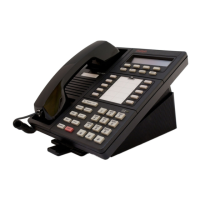MERLIN LEGEND Communications System Release 6.1
System Programming Guide
555-661-111
Issue 1
August 1998
Glossary
Page GL-6
CCS (common-channel signaling) Signaling in which one
channel of a group of channels carries signaling
information for each of the remaining channels, permitting
each of the remaining channels to be used to nearly full
capacity. In the system’s 100D module, channel 24 can be
designated as the signaling channel for channels 1–23.
centralized
telephone
programming
Programming of features on individual telephones;
performed at a central location by the system manager.
See also
system programming
and
extension
programming.
Centralized Voice
Messaging
The sharing of a voice messaging system by two or more
directly connected MERLIN LEGEND systems in a private
network. Available beginning in Release 6.1.
central office See
CO
.
Centrex Set of system features to which a user can subscribe on
telephone trunks from the local telephone company.
channel Telecommunications transmission path for voice and/or
data.
channel service
unit
See
CSU
.
checksum Sum of ones in a sequence of ones and zeros used to
detect or correct errors in data transmission.
circuit-switched
data call
Data call made through an exclusively established and
maintained connection between
data stations
.
class of restriction See
COR
.
clear data channel Clear data channels (also called unrestricted data
channels) allow the transmission of occurrences of more
than seven contiguous zero bits. If a clear data channel is
requested and only restricted channels are available, the
call will be rejected. See also restricted data channel.
clock
synchronization
When digital signals are transmitted over a
communications link, the receiving end must be
synchronized with the transmitting end to receive the digital
signals without errors using clock synchronization. A
system synchronizes itself by extracting a timing signal
from an incoming digital stream. All the digital facilities in a
network operate from a single common clock, preferably a
port connected to a digital
PSTN
facility on a
hub system
or
a system that connects two network systems. In this case,
all digital facilities specify a loop clock source. One system
in a network may be specified as a local clock source when
no functioning digital facility in the network is connected to
the
PSTN.
All other digital facilities then use this clock and
specify their clock sources as loop. Primary, secondary,
and tertiary clock sources are specified to allow backup
synchronization in the event that the primary source is out
of service.

